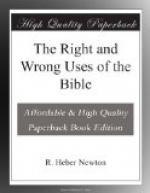In the present immature stage of this science of Biblical Criticism there are, of course, plenty of speculations and guesses, of hasty generalizations and crude opinions. Time will correct these. Meanwhile there is already so much that may claim to be well established as to constitute a new knowledge of these old books.
The historical books are seen to be the work of many hands in many ages. They gather up the popular traditions of the race, carry down on their slow streams fragments from such far back ages that we have almost lost the clue to their story—glacial boulders that now lie strangely out of place in the rich fields of later eras; songs of rude periods, nature myths, legends of semi-fabulous heroes, folk lore of the tribes, scraps from long-forgotten books, entries from ancient annals, pages torn from the histories of other peoples to fill out the story; the whole worked over many times by many hands in many generations.
Just as Thirlwall and Grote give us studies of Grecian history from the standpoint of Monarchism and Republicanism, so in the Kings and Chronicles we have studies of Hebrew history from a prophetic and priestly point of view.
The legislation of the Pentateuch, supposed formerly to have been drawn up by Moses, appears, as it now stands, to be a codification, made as late as the period of the Babylonian exile, under the influence of the hierarchical and ritual system, then crystallizing into the form familiar to us all. This codification, like its famous parallel in Roman history, the code of Justinian, collated the decisions and decrees already in existence from various periods, and reissued them as one body of laws.
It brings together the “Judgments” of early days upon questions of civil life—the decisions of tribal heads concerning the rights of person and property, the counterparts of the “Dooms” of English history; the moral rules of the local priests in a simple state of society; and the ritual and discipline of a late ecclesiastical age. The compilation is not very skilfully done, so that we pass from the minutiae of a priest’s vade mecum in a highly developed hierarchical period to the civil statutes of a rude patriarchal society, whose very crimes are archaic.
The prophecies break up into fragmentary collections, in which the words of many different and obscure prophets are grouped under the name of some great prophet, as was quite natural in an uncritical age; the whole mass being arranged with little chronological order.
The Psalter separates into several books of sacred song, dating from different periods. They repeat the same Psalm, and divide one Psalm into two and join two into one, on principles by no means apparent to us. Some of these Psalms are of a highly artificial and mechanical structure. There are acrostics, in which the couplets begin with the successive letters of the Hebrew alphabet; double acrostics, and other refinements of literary ingenuity; the sure signs of a flamboyant and decadent literature.




